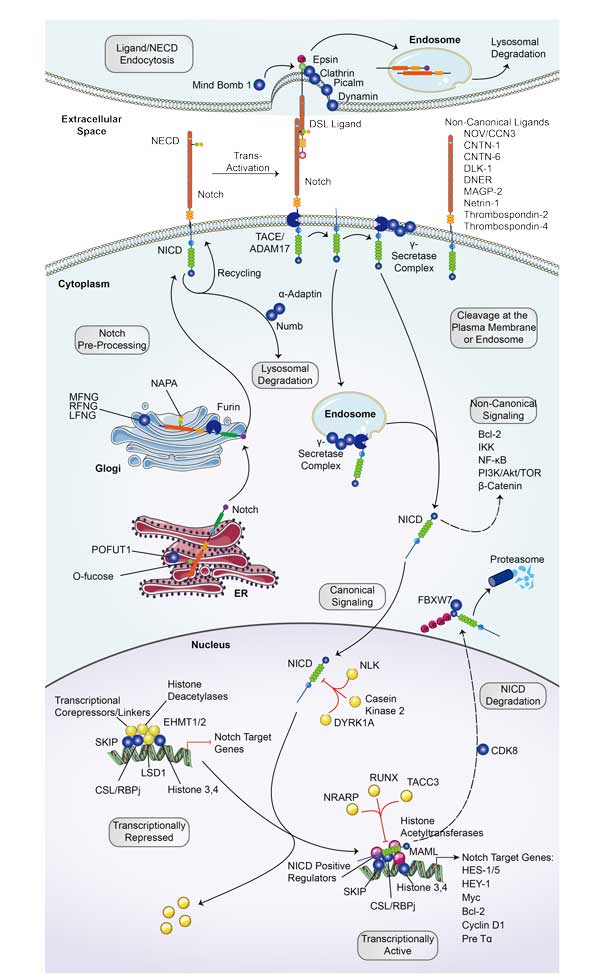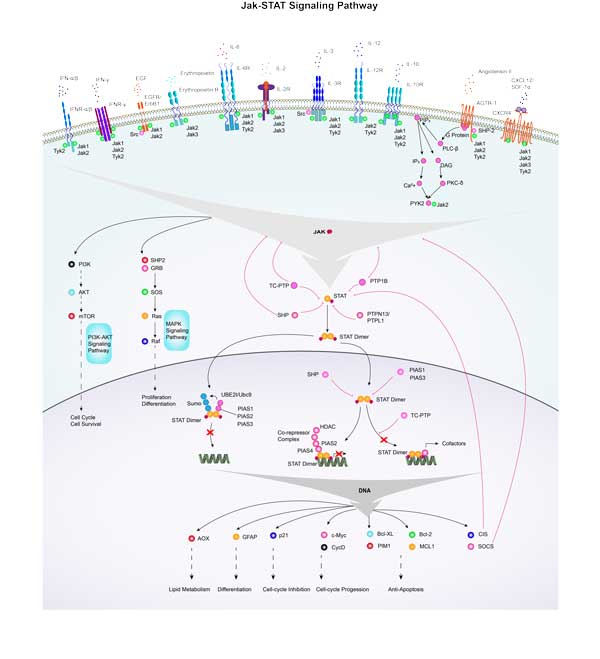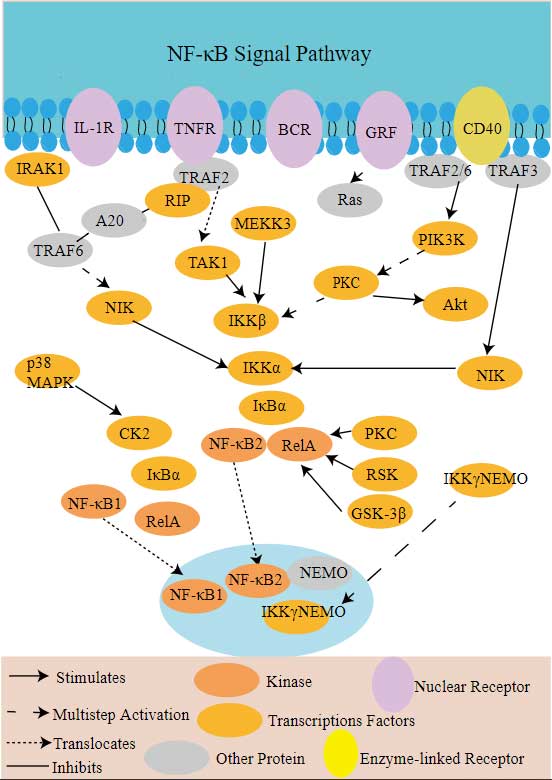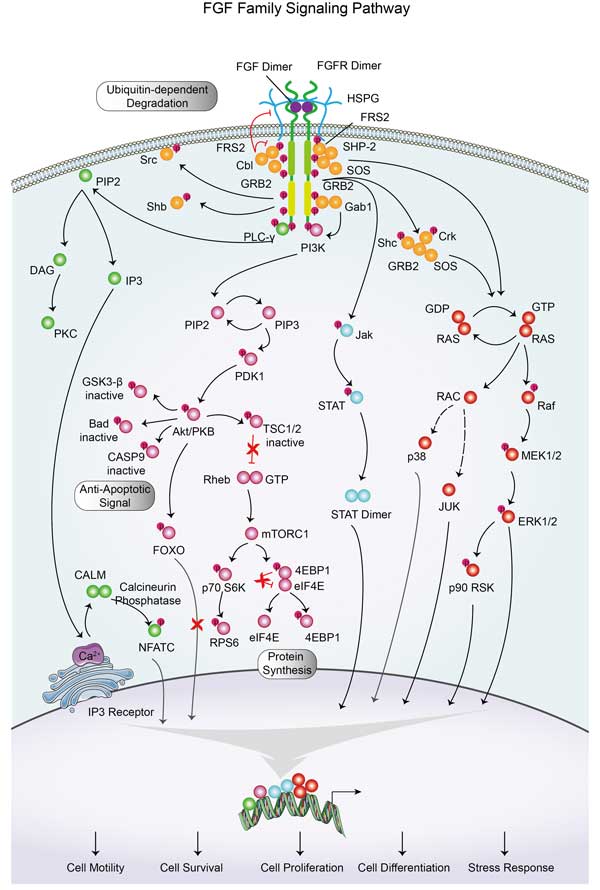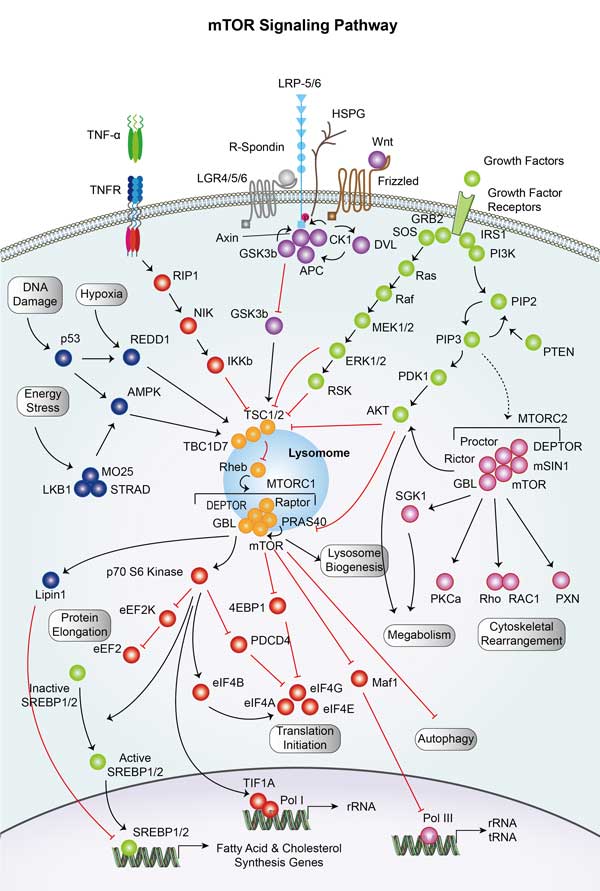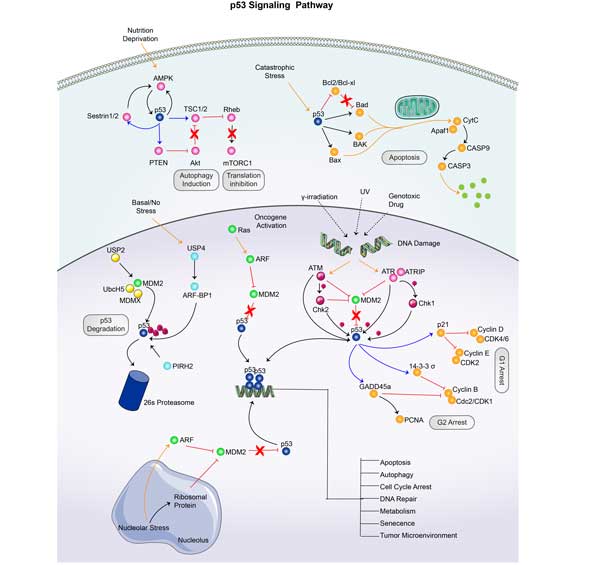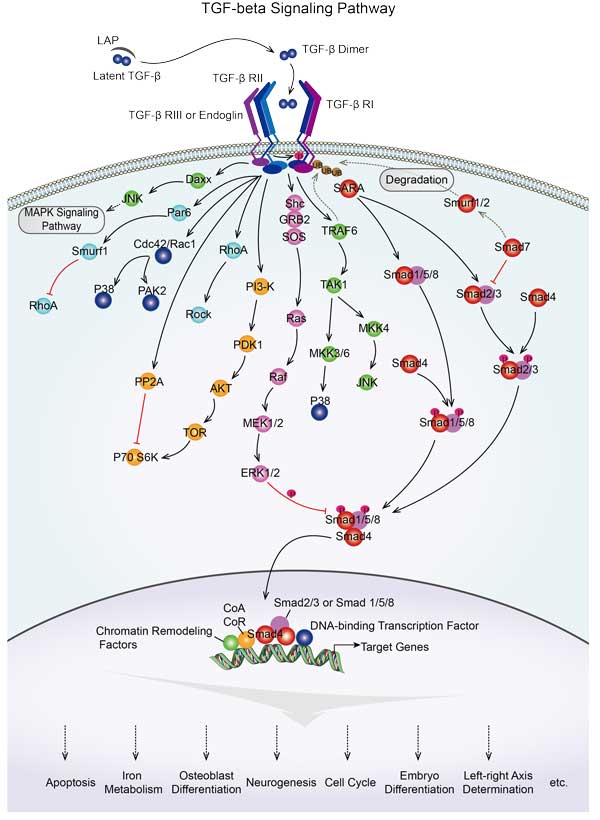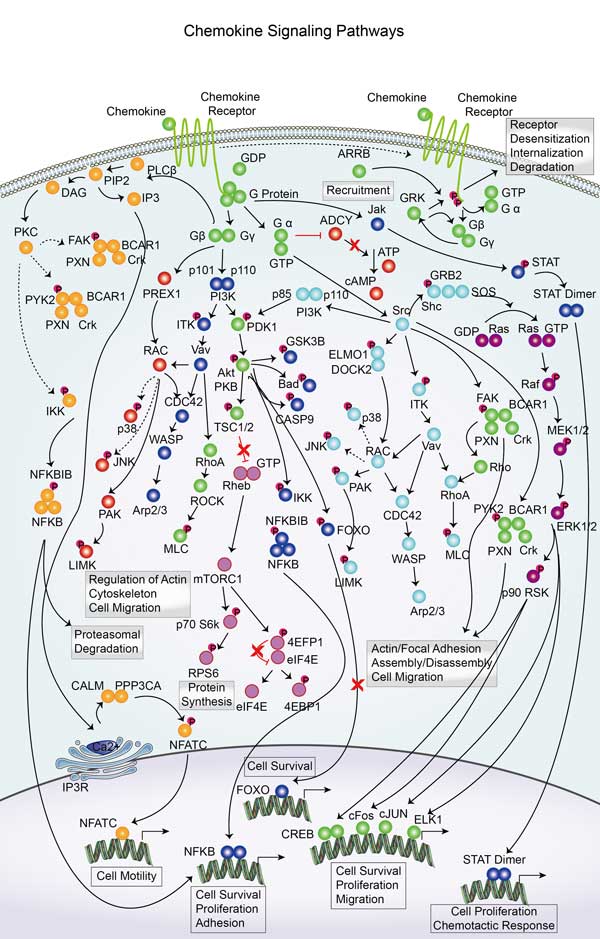AKT1
-
Official Full Name
RAC-alpha serine/threonine-protein kinase
-
Overview
Akt(protein kinase B, PKB) is a serine/threonine protein kinase. Akt is activated by PI3 kinase, which is itself activated by tyrosine kinase (Thr308, Ser473). Akt/PKB controls vital cellular functions such as cell survival/apoptosis, cell cycle progression and glucose metabolism. It also acts down-stream from growth factors and hormones. Akt/PKB can inhibit cell cycle arrest by phosphorylating p21. Also, Akt/PKB may potentiate cell cycle progression through increased translation of cyclin D. Akt/PKB directly affects the apoptosis pathway by, for example, targeting the pro-apoptotic Bcl-2 related protein, BAD. It also can phosphorylate three kinases upstream of SAPK. The SAPK system consists of two groups of kinases, and JNK and p38 MAP kinase pathways. The SAPK pathway is an important target for Akt/PKB regulation to promote cell survival. Akt/PKB is able to regulate cell survival through transcriptional factors(Forkhead, nuclear factor-kB(NF-kB), Murine double minute 2(Mdm2)) that are responsible for pro- as well as anti-apoptotic genes. One of the first physiological targets of PKB to be identified was glycogen synthase kinase-3(GSK3), which has been associated with the control of many cellular processes, including glycogen and protein synthesis, and the modulation of transcription factor activity. The involvement of Akt in disease processes like malignancy, neurodegeneration and abnormal glucose metabolism has also been demonstrated. -
Synonyms
AKT 1; AKT 2; AKT 3; AKT1; AKT2; AKT3; C AKT; CAKT; DKFZP434N0250; v-akt murine thymoma viral oncogene homolog 1; Murine thymoma viral (v akt) homolog 2; murine thymoma viral (v akt) oncogene homolog 1; Murine thymoma viral (vakt) oncogene homolog 1; PKB Akt; PKB alpha; PKB; PKB beta; PKBalpha; PKBBETA; PKBG; PRKBA; PRKBB; PRKBG; Protein kinase Akt 2; Protein kinase Akt 3; Protein kinase B; Protein kinase B beta; Protein kinase B gamma; RAC alpha; RAC alpha serine/threonine protein kinase; RAC; RAC beta; RAC beta serine/threonine protein kinase; RAC gamma; RAC gamma serine/threonine protein kinase; RAC PK alpha; RAC PK beta; RAC PK gamma; Rac protein kinase alpha; Rac protein kinase beta; RAC Serine/Threonine Protein Kinase; Serine threonine protein kinase Akt 3; STK 2; STK2; V AKT Murine Thymoma Viral Oncogene Homolog 1; v akt murine thymoma viral oncogene homolog 2; v akt murine thymoma viral oncogene homolog 3; VAKT Murine Thymona Viral Oncogene 1;
- Recombinant Proteins
- Cell & Tissue Lysates
- Protein Pre-coupled Magnetic Beads
- Antibody
- Chicken
- Human
- Human
- Mouse
- Rat
- Rhesus Macaque
- Zebrafish
- E.coli
- HEK293
- HEK293T
- In Vitro Cell Free System
- Insect Cell
- Insect cells
- Insect Cells
- Mammalian Cell
- Mammalian cells
- Mouse
- Protein Modification
- Rabbit
- Sf21
- Sf9 Insect Cell
- Wheat Germ
- 6xHis
- GST
- C
- His
- Myc
- DDK
- Flag
- GST|His
- His (Fc)
- Avi
- Strep
- His|MBP
- His|Strep
- MYC
- Myc|DDK
- N/A
- N
- No tag
- Involved Pathway
- Protein Function
- Interacting Protein
- AKT1 Related Articles
- AKT1 Related Gene Family
- AKT1 Related Research Area
- AKT1 Related Signal Pathway
AKT1 involved in several pathways and played different roles in them. We selected most pathways AKT1 participated on our site, such as MAPK signaling pathway, ErbB signaling pathway, Ras signaling pathway, which may be useful for your reference. Also, other proteins which involved in the same pathway with AKT1 were listed below. Creative BioMart supplied nearly all the proteins listed, you can search them on our site.
| Pathway Name | Pathway Related Protein |
|---|---|
| MAPK signaling pathway | NF1;ARRB2;HSP70;TP53;HSPA2;MAPK9;MEF2CB;MAP2K2A;AKT2 |
| ErbB signaling pathway | PAK1;MAPK9;TGFA;GSK3AA;GSK3B;PRKCBA;PAK6;AKT3A;ERBB4 |
| Ras signaling pathway | MAP2K1;PLA2G10;RRAS;FGF5;RASAL1;BRAP;PIK3R1;PGF;GNG4 |
| Rap signaling pathway | KRIT1;PDGFRA;PLCE1;Fgf15;FGF10;MAPK13;ID1;LPAR2;SRC |
| cGMP-PKG signaling pathway | PIK3R1;ATP2B4;KCNJ8;TRPC6;MEF2C;KCNMB3;PPP3CA;PLCB3;IRS4 |
| cAMP signaling pathway | CALM1;RRAS;PPP1CA;CALM4;BAD;HTR6;RAP1A;RAC2;CNGA3 |
| Chemokine signaling pathway | CCL11;RELA;AKT1;CCL18;CCL3L1;GNB3;Ccl27a;GNG5;GNG3 |
| HIF- signaling pathway | TIMP1;RBX1;CAMK2A;MKNK1;FLT1;MAPK3;ENO2;MAPK1;PIK3R5 |
| FoxO signaling pathway | PIK3R2;PIK3CB;HRAS;SLC2A4;AKT1;GRB2B;STAT3;GABARAPA;RAF1A |
| Sphingolipid signaling pathway | PLCB2;SGPL1;PPP2R5A;LASS2;MAP2K1;AKT2;PIK3CB;PRKCG;S1PR2 |
| Phospholipase D signaling pathway | AVPR1B;HRAS;MAPK3;KRAS;F2R;AVPR2;PIK3CA;FYN;SHC1 |
| mTOR signaling pathway | RPS6;IKBKB;AKT2;PIK3R5;PIK3R3B;HIF1AB;RPS6KB1B;MAPK1;VEGFAA |
| PIK-Akt signaling pathway | LAMB4;FIGF;PRKAA1;IRS1;TLR2;Ifna15;CD19;AKT1;LPAR3 |
| AMPK signaling pathway | HNF4A;IGF1R;INSR;AKT1S1;MTOR;TSC2;ELAVL1;CREB3;INS |
| Apoptosis | TRADD;PIK3CD;BAXA;IRAK2;Gzmg;DSG2;PIK3R3B;CASP7;PKP1 |
| Adrenergic signaling in cardiomyocytes | ADRA1BB;PIK3R3A;CACNA2D3;ATP1A3A;CACNA2D1A;PPP1CB;ADCY3;CALM3A;KCNE1 |
| VEGF signaling pathway | PRKCBB;SRC;MAPK13;PTK2AA;AKT2;PIK3CA;RAC1A;MAPK1;PTGS2A |
| Osteoclast differentiation | FCGR2C;IKBKB;MAPK11;FCGR2A;SIRP-BETA;IFNB1;OSCAR;SOCS3;PIK3CG |
| Focal adhesion | PIP5K1C;PPP1CAA;ACTB2;PTK6;PPP1CA;PPP1CBL;PIK3R5;PPP1CC;MAPK10 |
| Tight junction | VAPAL;CDC42L;PPP2CB;PPP2R2CA;TJP2;GNAI3;YES1;CLDN2;CDC42 |
| Signaling pathways regulating pluripotency of stem cells | RAF1;SMAD9;ACVR1B;BMP2;ZFHX3;Fzd4;MAPK11;LEFTY2;ESX1 |
| Platelet activation | PRKACB;ACTB;TBXA2R;ITGA2B;P2RX1;ROCK2;PIK3CD;MAPK13;VAMP8 |
| Toll-like receptor signaling pathway | NFKBIAB;MAP2K2A;TLR4BB;TLR1LA;TRAF3;TLR9;TLR3;MAP2K7;CD86 |
| Jak-STAT signaling pathway | TP-1;IL24;STAT1A;STAM2;IL12RB1;GM13305;STAT6;IFNPHI1;IFNA5 |
| T cell receptor signaling pathway | PAK2;ZAP70;MAPK1;CABIN1;CD3G;RELA;DEF6A;GSK3B;RAF1 |
| B cell receptor signaling pathway | CD81;CDK4;PPP3R1;HDAC5;RAC2;PIK3R3;VAV2;PIK3R2;Cd79a, Cd79b |
| Fc epsilon RI signaling pathway | MAPK8;MAP2K2;NRAS;MAP2K7;PDPK1;IL5;MAP2K6;PLA2G4B;TNF |
| Fc gamma R-mediated phagocytosis | PPAP2B;PLCG1;PLA2G6;FCGR3A;ARF6;LIMK1;PIK3CG;PIK3CB;PIK3R2 |
| TNF signaling pathway | MAGI2;FADD;CREB3L3;MAPK13;MAPK8;PIK3CA;AKT2;ICAM1;BIRC3 |
| Neurotrophin signaling pathway | ZNF274;BCL2;CAMK2D;PDPK1;NTRK3;BDNF;NTRK1;MAPK7;PSEN1 |
| Cholinergic synapse | CHRM2;KRAS;CREB3;CAMK4;GNA11;KCNJ3;CHRNB2;CREB3L2;PIK3CA |
| Dopaminergic synapse | PPP2R2A;CALM2;GNB1;ITPR3;MAOA;KCNJ9;PPP2R5A;CAMK2A;PLCB3 |
| Insulin signaling pathway | INSRB;EXOC7;MAPK3;PIK3CB;PIK3R2;MKNK2A;G6PCA.2;FBP1;MAPK8A |
| Progesterone-mediated oocyte maturation | CCNB2;BRAF;MAPK10;CPEB2;PIK3CG;RPS6KA1;MAP2K1;PIK3CB;CPEB3 |
| Estrogen signaling pathway | HSP90AA1;PRKACA;GNAO1;GABBR1;AKT2;ESR2;PRKACB;KCNJ3;AKT1 |
| Prolactin signaling pathway | STAT3;STAT1;INS2;GSK3B;GRB2;PIK3R5;GALT;INS;NEK3 |
| Thyroid hormone signaling pathway | PLCB3;NCOR1;ATP1A2;RXRB;KAT2B;GSK3B;PIK3R2;PRKACA;MED30 |
| Adipocytokine signaling pathway | PCK1;CAMKK2;RXRGA;MAPK8A;SLC2A1;PTPN11;ACSL3A;PRKAG2A;PRKAB1B |
| Regulation of lipolysis in adipocytes | PIK3CD;PIK3CG;LIPE;TSHB;AKT1;PIK3R1;FABP4;PRKG2;NPR1 |
| Insulin resistance | PIK3R5;AKT2L;PDPK1;PPP1CAA;PRKAG3B;INS1;SLC27A5;CREB3L3A;PRKCD |
| Non-alcoholic fatty liver disease (NAFLD) | NFKB1;NDUFC1;COX6B2;PRKAA2;INS2;PIK3CG;NDUFS7;NDUFA4L2;PRKAB2 |
| Carbohydrate digestion and absorption | GNAT3;G6PC3;AMY2A2;G6PC2;ATP1A1;AMY2A4;ATP1B3;SLC5A1;SLC2A5 |
| Chagas disease (American trypanosomiasis) | GNAS;CCL2;MAPK3;CD3G;IFNGR2;IFNB1;SMAD2;GNAO1;MAPK10 |
| Toxoplasmosis | BIRC8;MAP3K7;HLA-DPB1;AKT2;TYK2;IL10RA;MAPK12;BCL2L1;LAMB4 |
| Tuberculosis | IFNA2;CLEC4M;IL6;HLA-DRB4;IFNG;HSPD1;TRADD;TLR1;MAPK8 |
| Hepatitis C | CLDN4;DDX58;ARAF;NRAS;PPP2CB;RNASEL;MAPK10;MAPK9;IFNA13 |
| Hepatitis B | IFNA7;CREB5;IFNAR1;TGFB1;YWHAZ;CASP8;MAPK1;FAS;VDAC3 |
| Measles | IL13;PIK3CG;IFNA2;AKT1;IFNA12;IFNA6;EIF2AK4;IFNGR2;STAT5B |
| Influenza A | BLA;PML;DNAJC3;IFNG;H2-AA;IL33;Ifna11;MAPK13;HSPA1A |
| HTLV-I infection | EGR2;ITGB2;ZFP36;PRKACA;XPO1;H2-Q10;IL2RG;ITGB2L;CRTC3 |
| Epstein-Barr virus infection | POLR3C;POLR2A;PSMD4;YWHAH;PSMC6;PIK3R1;RB1;HSPB2;TBPL2 |
| Pathways in cancer | GNA12;NCOA4;PTCH2;WNT3A;BMP4;KRAS;LEF1;CCNE2;Flt3l |
| Proteoglycans in cancer | PTCH1;RPS6KB1;TLR2;PLCG1;PXN;RPS6KB2;FAS;RAC1;SRC |
| Colorectal cancer | TRP53;DCC;MAPK8;RAC1;AKT1;PIK3CA;APC;MAPK1;TGFBR2 |
| Renal cell carcinoma | SOS1;MAPK1;ARAF;RAC1;EPAS1;PAK7;PIK3CG;RBX1;KRAS |
| Pancreatic cancer | CCND1;TGFA;MAP2K1;RAF1;TGFB2;TGFBR2;ARHGEF6;MAPK9;PLD1 |
| Endometrial cancer | CTNNA2;BAD;AXIN2;PIK3CG;TP53;TCF7;AKT2;PIK3CA;ARAF |
| Glioma | PLCG1;PTEN;PDGFRA;PIK3CD;NRAS;PRKCB;PDGFB;CAMK2G;SHC4 |
| Prostate cancer | PDGFC;NRAS;PIK3R2;NFKBIA;CREB5;NFKB1;HSP90AB1;PDGFD;IKBKG |
| Melanoma | FGF17;FGF14;Fgf15;AKT2;NRAS;FGF12;PDGFA;RB1;FGF1 |
| Chronic myeloid leukemia | TGFB3;HRAS;TGFB2;MAP2K1;CRK;TRP53;CTBP1;TGFBR1;NFKBIA |
| Acute myeloid leukemia | PIK3CB;AKT2;NFKB1;PPARD;RPS6KB2;JUP;HRAS;AKT3;PIK3R5 |
| Small cell lung cancer | RXRA;AKT1;PIK3R3;TRAF3;LAMB1;PIK3CB;PTGS2;BIRC8;PTEN |
| Non-small cell lung cancer | AKT2;KRAS;MAPK3;MAP2K2;RXRG;PLCG2;RARB;CASP9;PDPK1 |
| Central carbon metabolism in cancer | HK1;PFKL;GLS2;PTEN;SIRT6;PKM2;PIK3CB;HK3;MAPK3 |
| Choline metabolism in cancer | PPAP2A;SLC22A2;AKT1;MAPK1;TSC2;PDGFA;RALGDS;HRAS;DGKQ |
AKT1 has several biochemical functions, for example, 14-3-3 protein binding, ATP binding, enzyme binding. Some of the functions are cooperated with other proteins, some of the functions could acted by AKT1 itself. We selected most functions AKT1 had, and list some proteins which have the same functions with AKT1. You can find most of the proteins on our site.
| Function | Related Protein |
|---|---|
| 14-3-3 protein binding | DDIT4;PRKCE;TSC2;AKT1;KIF13B;IRS2;HDAC7;ARRB2;KCNH1 |
| ATP binding | CSK;YME1L1;GRK5;NEK9;PRKCB;RAF1A;UBE2T;Fert2;PRPS1L1 |
| enzyme binding | TAL1;THRB;GSTM2;CD4;CASC3;CDK19;GRIN1;RFC5;ANK1 |
| identical protein binding | SERPINB1A;PHC2;MPST;DYNLT1C;MDM2;VCP;ACTG1;MSANTD3;SSNA1 |
| kinase activity | FAM20B;HIPK2;PRPS2;PTK6B;UCK2B;EPHB4B;PAK2A;CSNK1DA;RPS6KB1B |
| nitric-oxide synthase regulator activity | AKT1;CALM3;HSP90AB1;ESR1;CALM1;HSP90AA1.1;CALM2;HSP90AA1 |
| phosphatidylinositol-3,4,5-trisphosphate binding | ANXA8;RACGAP1;ZFYVE16;PIRT;INPPL1;AKT1;GBF1;GAB2;KIF16B |
| phosphatidylinositol-3,4-bisphosphate binding | ADAP2;PHLDA3;ANXA8;D6WSU116E;ZFYVE1;RAG2;TTPA;PLEKHA1;SESTD1 |
| protein binding | EEF1A2;RAB1A;RAPGEF6;GPI1;GPRIN2;IL28RA;ITGB1BP2;MAPK9;C15orf57 |
| protein kinase C binding | PEA15A;DACT1;HAND2;SDPRA;DACT3;PARD3;DACT2;SDPRB;TRPV4 |
| protein kinase activity | POMK;CHEK1;PRKCA;TNIKB;AVP;ROCK1;SRC;NIM1;NEK12 |
| protein phosphatase 2A binding | RPS6KB1;ANKLE2;SMG7;AKT1;FOXO1;CPD;BCL2;ENSA;STRN4 |
| protein serine/threonine kinase activity | PRKCZ;STK40;MAP3K2;CAMK2G1;CLK1;NEK2;TGFBR1A;TSSK1;MAP2K2A |
| protein serine/threonine/tyrosine kinase activity | PRKCG;CLK3;MAP2K1;RPS6KA2;CLK4;TESK2;PRKACA;ACVR2B;TTK |
AKT1 has direct interactions with proteins and molecules. Those interactions were detected by several methods such as yeast two hybrid, co-IP, pull-down and so on. We selected proteins and molecules interacted with AKT1 here. Most of them are supplied by our site. Hope this information will be useful for your research of AKT1.
MDM2; N/A; PPP2CA
- Q&As
- Reviews
Q&As (13)
Ask a questionYes, several drugs and agents have been developed to specifically target AKT1. These include small molecule inhibitors that directly target the kinase activity of AKT1. Examples of AKT1 inhibitors currently under investigation or in clinical trials include MK-2206, ipatasertib, and capivasertib. These inhibitors aim to block the activation of AKT1 and disrupt its downstream signaling pathways.
Yes, there are inhibitors that specifically target the activity of AKT1 protein. Small molecule inhibitors, such as MK-2206 and GSK690693, have been developed to block AKT1 activation and downstream signaling. These inhibitors are being studied as potential therapeutic agents for cancer treatment. Additionally, certain natural compounds, including resveratrol and curcumin, have been reported to inhibit AKT1 activity and exhibit anti-tumor effects.
Mutations in AKT1 have been implicated in certain diseases. For example, somatic mutations in AKT1 have been found in a subset of human cancers, such as breast, ovarian, and colorectal cancers. These mutations can lead to constitutive activation of AKT1, contributing to tumor development. Moreover, germline mutations in AKT1 have been linked to a rare genetic disorder called Proteus syndrome, characterized by asymmetric and progressive overgrowth of various tissues.
Yes, combining AKT1 inhibitors with other therapies is being investigated as a potential strategy for cancer treatment. AKT1 inhibition can enhance the efficacy of conventional chemotherapy agents or targeted therapies. For example, combining AKT1 inhibitors with inhibitors of the phosphoinositide 3-kinase (PI3K)/mTOR pathway, which upstream regulates AKT1, could provide a more comprehensive blockade of the pathway. Additionally, AKT1 inhibitors have also been tested in combination with immune checkpoint inhibitors to enhance immune response against tumors. Such combination approaches aim to improve treatment outcomes and overcome drug resistance mechanisms.
AKT1 signaling regulates numerous downstream targets involved in diverse cellular processes. Some of the well-known targets include the mammalian target of rapamycin (mTOR), which plays a role in protein synthesis and cell growth, and the pro-apoptotic protein Bad, which AKT1 phosphorylates to prevent apoptosis. AKT1 also phosphorylates and inactivates the transcription factor Forkhead box protein O (FOXO), which regulates genes involved in apoptosis, cell cycle arrest, and oxidative stress response. Other downstream targets of AKT1 include glycogen synthase kinase 3 (GSK3), nuclear factor-kappa B (NF-kB), and endothelial nitric oxide synthase (eNOS), among others.
Yes, AKT1 protein has the potential to be a therapeutic target for conditions beyond cancer. Due to its role in insulin signaling and glucose metabolism, targeting AKT1 activity could be beneficial in treating metabolic disorders such as type 2 diabetes. Strategies aimed at increasing AKT1 activity and sensitivity to insulin are being explored.
Targeting AKT1 mutations is an active area of research for therapeutic development. Due to the involvement of AKT1 in cancer progression, efforts are being made to develop specific inhibitors that can selectively target mutant AKT1 forms. Clinical trials are being conducted to investigate the efficacy of AKT inhibitors in patients harboring AKT1 mutations in various cancers. However, further research is still needed to fully understand the implications and potential therapeutic strategies for AKT1 mutations.
AKT1 protein is involved in numerous cellular processes. Some of its key functions include promoting cell survival by inhibiting apoptosis (programmed cell death), regulating cell growth and proliferation, and participating in glucose metabolism. It is also involved in the regulation of protein synthesis, cell cycle progression, DNA repair, and cellular migration.
Yes, certain natural compounds and dietary factors have been found to modulate AKT1 activity. For example, resveratrol, a polyphenol found in grapes and red wine, has been shown to inhibit AKT1 signaling and induce apoptosis in cancer cells. Curcumin, a compound found in turmeric, has also been reported to inhibit AKT1 activation and suppress tumor growth.
AKT1 protein is activated by a process called phosphorylation. When growth factor receptors, such as insulin receptors or receptor tyrosine kinases, are stimulated by their ligands, it triggers the activation of phosphoinositide 3-kinase (PI3K). PI3K then converts phosphatidylinositol 4,5-bisphosphate (PIP2) into phosphatidylinositol 3,4,5-trisphosphate (PIP3). PIP3 acts as a second messenger and recruits AKT1 to the cell membrane.
Yes, AKT1 mutations can contribute to drug resistance in cancer treatment. Mutations in AKT1 can lead to constitutive activation of its signaling pathway, rendering cancer cells resistant to targeted therapies that rely on inhibiting AKT1. For example, tumors with activating mutations in AKT1 may not respond to AKT1 inhibitors. Additionally, mutations in AKT1 or its upstream regulators such as PI3K can bypass the inhibitory effects of targeted therapies.
The activity of AKT1 protein is regulated through various mechanisms. In addition to phosphorylation, which activates AKT1, there are several factors that can modulate its activity. One important regulator is phosphatase and tensin homolog (PTEN), which dephosphorylates PIP3 and limits AKT1 activation. Other regulatory proteins, such as protein phosphatase 2A (PP2A) and protein kinase C (PKC), can also influence AKT1 activity by dephosphorylating or phosphorylating AKT1, respectively.
Dysregulation of AKT1 has been associated with various diseases and conditions. Apart from its prominent role in cancer, altered AKT1 signaling has been implicated in metabolic disorders such as diabetes and obesity. Reduced AKT1 activity is observed in insulin resistance, whereby insulin stimulation of AKT1-mediated glucose uptake is impaired. AKT1 dysregulation has also been linked to neurological disorders, including Alzheimer's disease and schizophrenia. Abnormal AKT1 signaling has been implicated in synaptic dysfunction, neuronal survival, and cognitive impairment associated with these conditions. Further research is needed to fully understand the mechanisms and implications of AKT1 dysregulation in these diseases.
Customer Reviews (1)
Write a reviewThe manufacturer's dedicated and knowledgeable support team is readily available to address any concerns, provide guidance, and offer timely solutions.
Ask a Question for All AKT1 Products
Required fields are marked with *
My Review for All AKT1 Products
Required fields are marked with *


